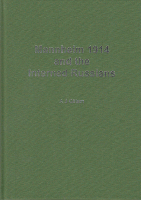Author A.J. Gillam sent us a commentary concerning the ChessCafe.com review of Mannheim 1914 and the Interned Russians. We present it this week as a Skittles Room extra!
The Review of Mannheim 1914 and the Interned Russians
I would like to comment on a couple of issues raised by your review of my book.
It is true that I spend two-and-a-half pages commenting upon errors in Di Felice’s Mannheim tables. I say in the book: “This section is not here for pedantic reasons nor is it a claim to superiority. It is here to show that I know what Di Felice has published and to say that I have strong reasons for my different version.”
Later, when commenting on both Di Felice’s and Gaige’s books of tournament tables, I ask, “Is it reasonable to expect an author working on hundreds of cross tables to devote the time necessary to eliminate these kinds of mistakes? The problem is that these reference books are usually considered to be authoritative and their errors are endlessly copied.”
The problem lies in my last few words – the errors are endlessly copied. Do readers understand that so much of what they read, and assume to be correct, is wrong?
Perhaps I should have added, in the book, that the Gaige and Di Felice books are invaluable reference sources which I refer to almost every day.
How many readers have read about “Dr. Alekhine”? Brian Reilly, the former editor of the BCM, who was a close friend of Alekhine’s when they both lived in Nice, France, in the late 1930s, decided to write a book on the life of Alekhine (which was never completed and is unpublished). He discovered that Alekhine became a student at a Paris university (not the Sorbonne) in order to study for a doctorate. Alekhine never completed the course and so was never a “Doctor”. Will it ever be possible to eliminate this error, which occurs in so many books?
In 1947 the British magazine Chess published a spectacular combination by Paul Felix Schmidt (later a grandmaster). The magazine wrote: “K.Richter sends us a superb finish to a game played by P.Schmidt in Heidelberg last year. Schmidt is the Estonian international and great rival of Keres, who opted for German citizenship early in the war.” (Chess 1946/7, page 288). Then followed the combination in which Schmidt sacrificed three pieces to force a mate in nine.
White to move
![[FEN "r1b2r2/3pNpkp/3pn1p1/2pN3P/2PnP3/q3QP2/4BKP1/1R5R w - - 0 1"]](https://chesscafe.com/wp-content/uploads/2014/09/skittles459a.gif)
[FEN “r1b2r2/3pNpkp/3pn1p1/2pN3P/2PnP3/q3QP2/4BKP1/1R5R w – – 0 1”]
The German magazine Schach 1947 pp106/7 said the game was Paul Schmidt v Paul Schmidt (the father) on a “family occasion” (in other words in an informal game). 1.Qh6+!! Kxh6 2.hxg6+ Kg5 3.Rh5+!! Kxh5 4.f4+! Nxe2 5.Nf6+ Kh6 6.Rh1+ Kg7 7.Ne8+!! Rxe8 8.Rxh7+ Kf6 9.Rxf7 mate. [Note if 4…Qf3+ 5.Bxf3+ Nxf3 6.Rh1+ Nh4 7.Nf6+ Kh6 8.Rxh4+ Kg7 9.Ne8+ Rxe8 10.Rxh7 and 11.Rxf7 mate.-ed.]
I believe that the source of many of Di Felice’s errors lies in his lack of language skills. I have the same problem. This considerably increases the risk of error.
Today’s researchers are considerably better placed than those of the past. We can get access to original sources so much more easily. Old magazines and books have been reprinted, many newspapers and other sources are available online, and email enables quick and easy communication with other researchers and their knowledge. Today’s books should be more accurate but we still have the problem of eliminating all those things that readers think they “know”.
That brings me to me second point – the imprisonment of the Russians in Rastatt. They were kept in the military prison for a couple of days in bad conditions and then transferred to the civilian prison where things were better, but it was still a prison!
In the book, I give long, detailed and authoritative accounts of these ten days by both Maljutin and Bohatyrchuk. Their stories agree and appear to be reliable. I also give a couple of accounts by Alekhine which are briefer but reasonably consistent with what Maljutin and Bohatyrchuk have to say. The chief difference is Alekhine’s account of his relationship with the warden’s daughter compared with what Bohatyrchuk has to say.
We know that Alekhine is an unreliable witness. He originally said he escaped from Germany but later told the truth. He is known to have doctored games scores to make his play look more spectacular, and there are other examples (the “doctorate”). However, his description of the conditions in Rastatt are consistent with those of Maljutin and Bohatyrchuk, and they are no different from what you would expect.
In contrast, Hans Mueller and A.Pawelczak, in a book first written in 1953, in German, for a German audience, say that Alekhine’s existence in this prison was “idyllic”. They do not say where this information came from, but they were hardly going to advance the sales of their book if they wrote about how bad the prison conditions were. I do not comment in the book on what they have to say, because it simply is not believable. Of course, in 1953, Bohatyrchuk had not yet written his account and Mueller and Pawelczak would not have known about Maljutin’s newspaper articles nor, for that matter, Alekhine’s articles in English and Russian from nearly forty years earlier.
It is possible that the unreliable Alekhine did say something similar to what they report, to suit his own purposes, but where did he write it? The description of the conditions in the civilian prison is simply not believable and we now have three consistent accounts saying otherwise.
Thank you, Mr. Reviewer, for providing such a good example of how difficult it is to eliminate the errors of the past, because they are endlessly repeated. A little knowledge is a dangerous thing.
© 2014 ChessEdu.org. All Rights Reserved.




Leave a Reply